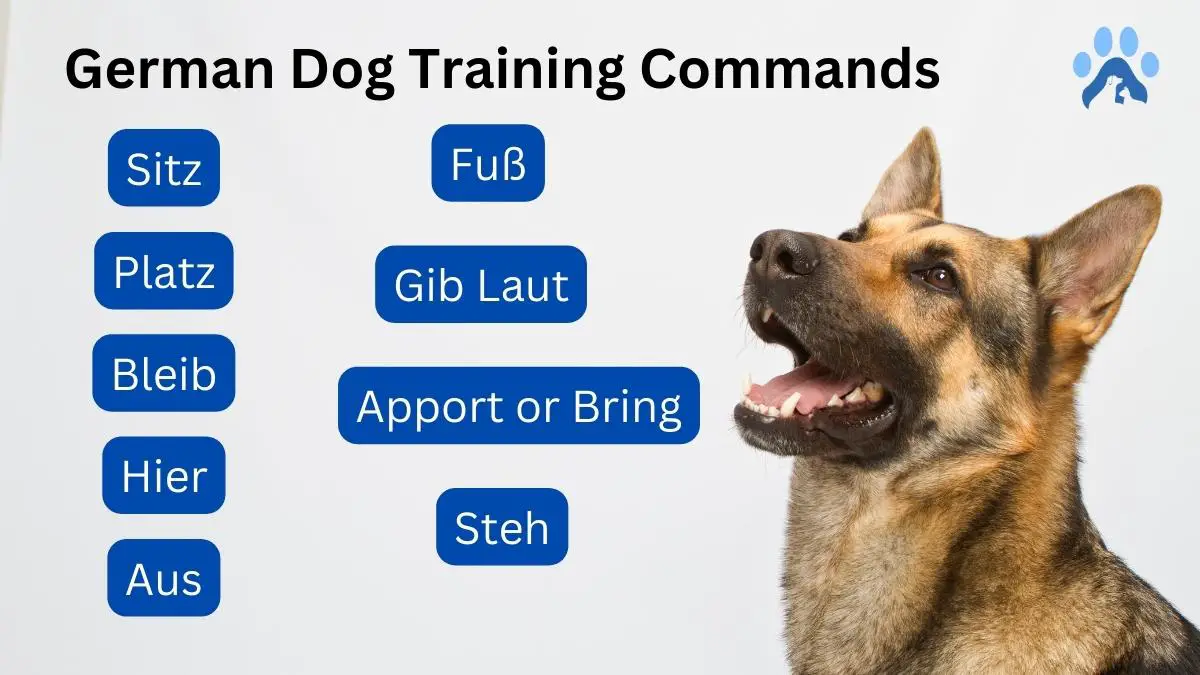Are you tired of shouting “sit” and “stay” to your furry companion without any results? Have you ever considered using German dog training commands? These commands are not only effective, but they can also add an air of sophistication to your dog’s training. You might feel like you’re barking orders in a foreign language at first, but with practice, your dog will quickly learn these commands and respond to them with ease.
In this article, we’ll provide you with a comprehensive guide to German dog training commands and show you how to train your dog like a pro.
Comprehensive List of German Dog Training Commands
Here’s a list of some common German dog training commands and their English translations:
- Sitz (pronounced “sits”) – Sit
- Platz (pronounced “plats”) – Down
- Bleib (pronounced “blibe”) – Stay
- Hier (pronounced “hee-er”) – Come
- Aus (pronounced “ows”) – Drop it/Release
- Steh (pronounced “shtay”) – Stand
- Fuß (pronounced “foos”) – Heel
- Gib Laut (pronounced “gib lowt”) – Speak/Bark
- Apport or Bring (pronounced “ah-port” or “bring”) – Fetch
Tips for Using German Dog Training Commands Effectively
Here are some tips for using German dog training commands effectively:
- Be Consistent: Consistency is key when it comes to dog training. Using German dog training commands requires you to be consistent with the words you use and the tone of your voice. For example, if you want your dog to sit, always use the command “Sitz” and say it in the same tone of voice. This will help your dog learn the command more quickly and respond to it consistently.
Example: “Sitz” should always be used when you want your dog to sit. If you start using “Sit” or “Sit down” instead, your dog may become confused and not respond to the command as quickly.
- Use Positive Reinforcement: Positive reinforcement is a key component of dog training, regardless of the language you use. When your dog follows a command correctly, reward them with a treat or praise. This will encourage your dog to continue following your commands and make training a positive experience.
Example: When your dog responds correctly to the “Platz” command, which means “down,” reward them with a treat and verbal praise, such as “Good job, well done!”
- Keep Commands Short: German dog training commands are typically short and to the point. This helps your dog understand the command quickly and respond to it immediately. For example, “Hier” means “come here,” and “Fuss” means “heel.” Keep your commands short and clear to avoid confusion.
Example: Instead of saying “Come on over here, boy,” simply use the command “Hier” to get your dog to come to you.
- Use Body Language: Dogs respond well to body language, so use it to your advantage when giving commands. When you give a command, use a hand gesture or body movement to reinforce the command and help your dog understand what you want them to do.
Example: When giving the “Bleib” command, which means “stay,” use a hand signal, such as holding your palm out in front of you, to reinforce the command.
- Practice, Practice, Practice: Like any skill, using German dog training commands effectively takes practice. Don’t expect your dog to learn the commands overnight. Set aside time each day to practice with your dog, and be patient. With consistent practice, your dog will become fluent in these commands.
Example: Set aside 10-15 minutes each day to practice German dog training commands with your dog. Start with basic commands, such as “Sitz” and “Platz,” and gradually add more commands as your dog becomes more proficient.
Pronunciation Guides
Correctly pronouncing German dog training commands is important for effective communication with your dog. Here’s a guide to pronouncing some common German dog training commands:
- Sitz: “sits”
- Platz: “plats”
- Bleib: “blibe”
- Hier: “hee-er”
- Aus: “ows”
- Fass: “fahs”
- Fuß: “foos”
- Apport: “a-por”
- Such: “sookh”
- Gib Laut: “gib loudt”
Mastering German Dog Training Commands: Tips, Personal Experiences, and Anecdotes
- When I was out walking my dog, she spotted a squirrel and began chasing it. I instantly cried out “Hier” (German for “come”), and to my astonishment, she immediately stopped following the squirrel and trotted back to me. I was astounded by how fast and consistently she replied to the instruction, and it was an excellent demonstration of how successful these commands can be.
- On another occasion, I walked my dog off-leash and she got a little too far away. I gave the “Fuss” command (which means “heel” in German), and she quickly returned to my side and began walking peacefully by me. It was an excellent demonstration of how these instructions can keep your dog safe and under control in any setting.
In general, my personal experiences with German dog training commands have been really pleasant. They’ve helped me efficiently train my dog, keep her safe, and strengthen our bond. If you’re searching for a fresh and effective technique to train your pet, I highly recommend giving them a try.
Expert Advice: Why German Dog Training Commands Are Highly Effective According to Dog Training Experts and Veterinarians
Many dog training experts and veterinarians recommend using German dog training commands as an effective way to train your furry friend. According to Dr. Sophia Yin, a veterinarian and animal behavior expert, using clear, concise commands can help your dog understand what you want them to do and make training more effective. She recommends using German commands because they are short and easy to distinguish from one another, making them ideal for training.
Similarly, renowned dog trainer Cesar Millan recommends using German dog training commands for their simplicity and effectiveness. He suggests starting with basic commands like “sit” and “stay” and gradually adding more advanced commands like “heel” and “come.” He also emphasizes the importance of consistency and positive reinforcement in dog training, which can help your furry friend learn quickly and build a strong bond with you.
According to the American Kennel Club (AKC), using German dog training commands can be highly effective for training your dog. They recommend using short, one-word commands that are easy to remember and distinguish from one another. The AKC also advises using positive reinforcement, such as treats or praise, to reward your dog for good behavior.



